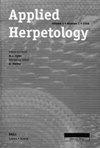Methods in herpetological forensic work — clinical techniques
引用次数: 2
Abstract
Biologists, law enforcement officials and veterinarians are routinely called upon to investigate reptile cases for abuse, neglect, illegal importation, and abandonment. While pursuing these situations, it is important that evidence is collected in an organized and systematic way to ensure successful prosecution or to mount a defense. There are different types of evidence that can be amassed to diagnose a disease/condition in a reptile case. Antemortem clinical investigations can be conducted for those cases where the animals are alive, while postmortem examinations should be pursued for animals that have expired. The purpose of this article is to review the common antemortem clinical techniques that can be used for forensic cases. There are a number of clinical diagnostics available for the forensic case, including the physical examination, clinical pathology, parasite diagnostics, infectious disease diagnostics, clinical toxicology, and diagnostic imaging. In addition to the clinical techniques, it is important to review and document the methods used to house and care for the animals. For this, a thorough review of the husbandry practices provided for the animal is needed.爬行动物法医工作方法。临床技术
生物学家、执法官员和兽医经常被要求调查虐待、忽视、非法进口和遗弃爬行动物的案件。在处理这些情况时,重要的是要以有组织和系统的方式收集证据,以确保成功起诉或进行辩护。在爬行动物病例中,可以收集不同类型的证据来诊断疾病/病症。在动物还活着的情况下,可以进行死前临床调查,而在动物已经死亡的情况下,应该进行死后检查。本文的目的是回顾常见的临死前临床技术,可用于法医案件。有许多临床诊断可用于法医案件,包括体格检查、临床病理学、寄生虫诊断、传染病诊断、临床毒理学和诊断成像。除了临床技术,重要的是审查和记录用于饲养和照顾动物的方法。为此,需要对提供给动物的饲养方法进行彻底的审查。
本文章由计算机程序翻译,如有差异,请以英文原文为准。
求助全文
约1分钟内获得全文
求助全文

 求助内容:
求助内容: 应助结果提醒方式:
应助结果提醒方式:


